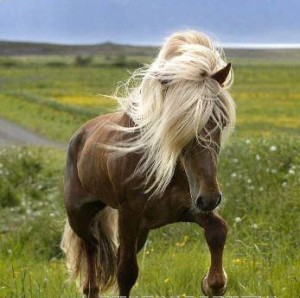Nordlandshest / Lyngshest horses, also known as the
Northlands horse or Northlands pony, originated in Norway. They are the
smallest of the three Norwegian national horse breeds. They originated in
Lyngen, but were given the name Nordlandshest in 1968 by breeders in that area.
The name change was hotly disputed by breeders in Lyngen and surrounding areas,
but a compromise was later reached, and today their official name is both
Nordlandshest and Lyngshest.
The first documentation of Nordlandshest / Lyngshest horses
date back to 1898, in Lyngseidet, Troms. Organised breeding began in the 1930s,
when most of the breed population lived in the northern counties of Norway. Many
of them died and few were bred during World War II, and they remained
endangered into the 1960s.
There were only about 15-20 left, mostly older mares, and
only one stallion; Rimfakse, from whom all Nordlandshest / Lyngshest today
descend. The breed was saved due to the efforts of people like Christian
Klefstad who laboured intensely to bring the breed back, traveling all over
northern Norway to gather fertile horses for breeding. By 2005, approximately
3000 horses were in the national registry, and about 200 foals are born every
year. In 2013, approximately 2500 individuals were reported to be registered,
with annual births of approximately 200.
Nordlandshest / Lyngshest horses are a small and sturdy horse
with drive and eagerness to work. They are surefooted and very strong
considering their size. They typically have a little feather on their legs and
they grow a heavy winter coat. Their height at their withers varies between 12.1
and 14.1 hands (49 and 57 inches, 124 and 145 cm), with most horses falling
between 12.3 to 13.3 hands (51 to 55 inches, 130 to 140 cm).
Their gait is smooth, correct, and agile with good
overreach. Emphasis is placed on good hock action in all gaits. Their trot is
energetic and ground-covering with good suspension. Their gallop is light with
good rhythm.
They are found in chestnut, bay, black, palomino, buckskin,
silver dappled bay, silver dappled black, silver dappled buckskin, and gray.
BEC/Blue-eyed cream individuals may not be accepted in the studbook. Star and
blaze are common markings, but blazes extending to the eye area, bald faces,
and stockings reaching or exceeding 1/3 of the cannon on hind legs are
discouraged. Blue eyes, white markings on the body, and "white reaching
the skin of the forelegs" are disqualifying faults.

